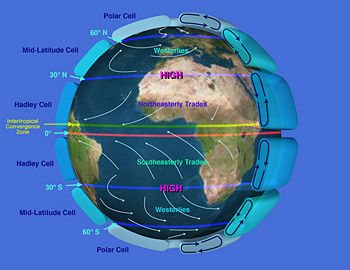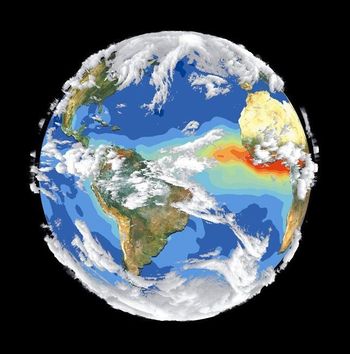Climate
 From Citizendium
From Citizendium Climate, from the Greek word klima (κλίμα), is the overall weather pattern for an extended period for any defined geographical location which may be over any size of area up to and including the entire Earth. Climate differs from weather in that on a particular day in a desert, for example, there may be rainy weather, but for most days for many years there is little or no rain—rainy weather for a day in a desert climate for many years. Two places, in other words, like Bombay, India and Vladivostok may both have similar weather for a brief time, such as a cloudless, sunny day, but their climate is extremely different. Put another way, weather may change from day to day or hour to hour, whilst climate is the average weather pattern for many years. Commonly the weather patterns that define a climate are averaged for a period of 30 years.
Climate is also different from season. A season [1] is usually a period of time of months, in which the weather can change drastically. Typhoon season in Asia is very windy and rainy. In some places it may rain a great deal for many months. The reminder of the year, the weather can be virtually without rain.
Climate variables include, precipitation (frost, fog, rain hail storms, snow), humidity (water vapour in the air), wind, amount of sunlight, temperature and other measures of weather.
Factors and mechanisms influencing climate[edit]
Weather patterns and overall climate are influenced by
- latitude - The farther from the equator a region is, the cooler the average temperature will be. This is because mean annual insolation[4] is higher at the equator and decreases toward the poles.
- altitude (or how high an area is above sea level) - The top of a mountain is always cooler than the bottom of the mountain.
- distance from the ocean - Areas far away from an ocean have greater changes in temperature than areas close to the ocean. Oceans have in fact a great heat capacity, which mitigates the climate.
- wind - Direction and speed of winds that reach an area. Wind may carry water vapour, cold air, dry air, a number of possibilities that will effect weather and to that extent, climate. For example, wind patterns over Europe are a fundamental component of a major climate cycle called North Atlantic Oscillation (NAO).
- vegetation – Plant life will absorb heat and water. Holding on to the heat after sunset it will create a zone of increased warmth for longer periods than a desert. Holding more water it will evaporate over longer periods of time slowing the process of drying and thus slowing the process of cooling while actually increasing the period of cooling. Non-vegetated areas may hold a great deal of heat but may also lose the heat at different rates, resulting in a shorter or longer heating and cooling period. Desert climates for example can be very hot in the day, but will rapidly cool off after sunset. Urbanised areas, on the other hand, while largely denuded of vegetation are often composed of materials that hold greater amounts of heat and will take longer to cool than a heavily vegetated area. Urbanised areas will also hold less water and the decreased amount of evaporation will also increase the period of cooling.
- aerosols – Aerosol particles (air-born particles of liquid or solid) may be natural or man-made. Aerosols have an effect on the energy balance of the atmosphere:
- directly scattering and absorbing radiation,
- serving as condensation nuclei during cloud formation,
- influencing precipitation.
Naturally occurring aerosols are from various sources including dust storms, sea-salt from sea spray, particles from forest and grassland fires, volcanic eruptions and biogenic emissions from crops, trees, and other vegetation. Human activities also produce aerosols from pollution through industrial processes and burning fossil fuels, by altering natural surface cover, and through fires. Human made aerosols comprise about 10% of the total, especially in industrialised sites, slash and burn agricultural regions and over-grazed grasslands. Aerosols are also created and modified by chemical processes in the atmosphere and are continuously cycled among the earth's oceans, atmosphere, and biosphere. Aerosols also affect photosynthesis and agricultural production and, eventually, vegetative cover.
Factors and mechanisms influencing atmospheric circulation[edit]
Among other factors, climate strongly depends on atmospheric circulation. Some factors determining it are:
- solar radiation – Large atmospheric convection currents which contribute to weather patterns are generated at the equator, which gets the greatest amount of solar radiation, and the combined effect of the Earth’s rotation (Air acts like a fluid and is churned by the Earth’s rotation). This is a major circulation pattern known as Hadley cell. In addition, as the air is heated, it rises. As it rises it creates turbulent areas which generate wind and it loses heat and moisture. After it has lost sufficient amounts of heat, the cooled air settles, is then warmed by the heat radiating from the Earth’s surface and the process begins anew. Cooler air is also more dense that warmed air and the more dense air pushes the less dense air creating yet another movement of the atmosphere.
- Coriolis Effect - Air acts like a fluid and is churned by the Earth’s rotation. The Earth’s rotation gives the air at the Equator a sideways push, curving to the right in the Northern Hemisphere and to the left in the Southern. As air rises or curves its initial speed is greater than the rotation of the Earth the further north or south that it ascends. When convection cells converge they create jet streams.
Climatology[edit]
Climatology, the study of climates, is a combination of atmospheric science, hydrology, geology, meteorology, astrophysics and other fields. Global warming, a major focus of climatology, is studied to determine its causes and potential effects. See the main article about global warming for a discussion of the current theories concerning its causes.
Paleoclimatology[edit]
Paleoclimatology is the study of ancient climates. Different types of rock and minerals form under specific climatic conditions: wet and dry, warm and cool. This is also true of ancient life forms whose presence may be determined from the fossil record. As the earth’s climate changes and continents move due to plate tectonics, the amount of sunlight received locally will vary, leading to changes which then are registered in strata. Coal deposits develop under wet conditions, bauxite deposits are evident where it was warm and wet, evaporites and calcretes occur under warm and dry conditions, and tillites where it was wet and cool. The ancient distribution of different rock types provide evidence of how the global climate has changed through time and how the continents have travelled across climatic belts.[11]
Microclimate[edit]
Microclimates are distinctive, small-scale climates that are specific defined areas, such as valleys or regions on either side of a geological feature such as a mountain range that alters the precipitation, wind, sunlight, humidity to such an extent as to make the locale climatically different from the surrounding areas. A heavily wooded park within a industrialized urban setting will differ climatically from the surrounding buildings and paved areas, a valley branching off a large region of desertification may offer significant climatic variables. [12][13]
Over time, plants and animals may adapt to these different microclimates to such an extent that they may thrive in a small defined area with a specific microclimate and yet if they are moved a short distance they will languish and show reduced growth and health, possibly even reduced ability to multiply.
Microclimate may also refer to artificially controlled environments such as homes, office buildings, botanical gardens, archives or museums where specific requirements are not naturally available.[14][13]
Natural microclimate[edit]
Artificial microclimate[edit]
Urban Regions[edit]
Urban heat islands are microclimates created by urban areas that are composed of large amounts of building materials, machinery and associated to artificial heating. Buildings and paved areas such as streets and parking lots do not absorb rainwater and retain heat generated by solar radiation. Industry and vehicles also generate significant amounts of heat. The decrease in vegetation and exposed soil also increases temperature as a result of reduced evaporation from natural sources and, thus, reduced humidity. The process of evaporation uses latent heat and reduces temperature. Urban areas also generate pollution, introducing large concentrations of aerosol and naturally and non-naturally occurring atmospheric gases.[15]
References[edit]
- ↑ Greek ωρα (ôra): division of the year, Latin sătĭonem (nom. satio): a sowing or planting. Possibly derived from 14th century, Old French seson, or seison (Modern French saison) from Latin serere ‘to sow’.) Confer: [1] Woodhouse’s English – Greek Dictionary, University of Chicago Library; [2] Charlton T. Lewis, Charles Short, A Latin Dictionary, Perseus Digital Library, Tufts University; [3] Compact Oxford English Dictionary; [4] Online Etymology Dictionary
- ↑ Glossary of Climate ChangeCalifornia Climate Change Portal
- ↑ What is the difference between climate and weather? Climate Change, Environmental Protection Agency, USA
- ↑ a word derived from INcoming SOLar radiATION or, the amount of sunlight
- ↑ General Climate Digital Atlas of Idaho
- ↑ Aerosols: Climate and Air Quality Earth System Research Lab, National Oceanic and Atmospheric Administration
- ↑ Biogenic emissions inventory California Environmental Protection Agency, Air Resources Board
- ↑ SAGE III What are aerosols? Earth Observatory, NASA
- ↑ Convection Jet Propulsion Laboratory, NASA
- ↑ El Niño explained Dept. of Geology & Geophysics, University of Wisconsin-Madison
- ↑ Paleogeographic Method Christopher R. Scotese, University of Texas, Arlington
- ↑ Microclimates Met Office
- ↑ 13.0 13.1 Microclimates BBC Weather
- ↑ Environmental control in museums and archives by microclimate technologies Microclimate Technologies International Inc.
- ↑ Urban Heat Islands BBC Weather
Categories: [Suggestion Bot Tag]
↧ Download as ZWI file | Last modified: 11/22/2024 23:15:17 | 24 views
☰ Source: https://citizendium.org/wiki/Climate | License: CC BY-SA 3.0


 KSF
KSF